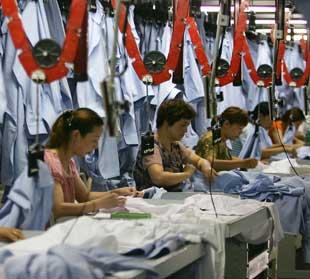
Is Wish just a wishful idea, or actually a progressive platform?
While the word “wish” is just a simple verb for most people, for today’s youth it often means something entirely different. Wish is associated with an online e-commerce company that sells (knock-off) products for incredibly cheap prices. But while Wish is now a global phenomenon, there is a lot of mystery surrounding it. How can the prices be so low? What is the catch? Where do these products even come from? Even though the answers to these questions might not be ideal, finding them is necessary to solve a serious problem.
What is Wish?
Wish started off in 2010 as a wishlist-creating phone application which earned its revenue by linking users to websites with similar-looking products to the ones on their wishlists. These products were sold for incredibly low prices, which was largely made possible by the fact they were produced in a cheap-labor country: China. In 2013 this scheme changed, and Wish became an electronic commerce site by asking merchants to sell their products directly on the Wish app (the merchants/production companies, however, are still located in China). In this set-up, Wish takes a portion of each sale. With time Wish continued to grow in size and popularity, until finally in late 2015 Business Insider reported that Amazon and Alibaba had approached Wish with acquisition offers reportedly up to 10 billion dollars, an offer which Wish refused.
Wish became the most downloaded shopping app in the USA of 2017: it garnered 32.5 million US downloads compared to Amazon’s 29.2 million
Wish grew to this size largely thanks to its unique (at least at that time) marketing strategy, meaning that Wish advertised mainly online;not only on Facebook (where it was the second largest advertiser in 2017, with an annual spending of $100 million), YouTube, Instagram etc., but also through online influencers in sponsored posts and videos. Because of this online approach, it is a very successful business internationally. To further illustrate this point: Wish became the most downloaded shopping app in the USA of 2017 (it garnered 32.5 million US downloads compared to Amazon’s 29.2 million).
How does it work?
So how does ordering something from this e-commerce giant work? While Wish has a website, there’s only a limited number of items that can be ordered from there. To get access to all products, downloading the app is necessary. Once on the app, a simple search will reveal that virtually anything can be found on Wish, mostly with price points deeply below the average market price. Scrolling further will reveal that Wish even offers a selection of “free” items. When going through check-out though, most consumers will notice that there’s one catch: the shipping has to be paid separately for each item, even if it is shipped by the same online merchant. This is also the case with the free items: they come with shipping prices that often compensate for the lack of an actual price. While the ethics of this are questionable, it does not seem to be illegal. Two other catches that are only noticeable after ordering are the shipping time and the (lack of) quality of the items. Since the items are shipped from China, they often take upwards of a month to arrive. Once they do arrive, the products often look very different from what was pictured on the app/website. If this is the case, most customers will thereafter find out that Wish’s refunding system and customer service leaves much to be desired, as many customers report being completely ignored.
So, while there are many disadvantages to ordering from Wish, its clever advertising and low pricepoints still make it one of the leading e-commerce sites/apps in today’s society, especially among young people.

E-Commerce
Wish's global influence
Because Wish can be used by anyone anywhere in the world with a phone and an internet connection, it is a clear case of globalization. Contact between different parts of the world has become faster, easier and more common. Wish connects sellers from China with customers from all over the world, and if the interaction ends ideally, products are shipped from one side of the earth to the other.
Wish is heavily featured in today’s online culture, but it is most prominent on YouTube. There are a multitude of hauls, reviews and many other types of videos to be found on the website. Sponsored or not, these videos attract attention to Wish’s initiative and consequently increase the online traffic on their site. Because even though these reviews are often negative (quality and delivering time are commonly discussed downsides), they make potential customers curious. While these customers know the products they receive might not exactly be what they expected, the possible profit is worth the risk to them. Since these products are sold very much below the average market price, people are willing to compromise on their expectations for a product. The ethics behind this reasoning, however, might be questionable.

A Chinese Sweatshop
For people living in core countries, there are really no negative consequences to Wish. Ordering online is simple and cheap, and there is a big selection of products to chose from. The products generally are qualitatively okay considering their price, and if they are not, the loss is minimal. On the other hand of this production process, however, the problems are a lot bigger. If these products are this cheap, there must be a cut in expenses somewhere, and the harsh truth is that with big companies like this operating in low-wage countries like China, these cuts are usually made at the expense of the manual laborers. If a backpack is sold online for five euros, the lowest level worker only makes the tiniest fraction of this price.
A really appropriate way of analyzing Wish’s global consequences is by using Immanuel Wallerstein’s World-Systems Analysis
A really appropriate way of analyzing Wish’s global consequences would be by using Immanuel Wallerstein’s World-Systems Analysis (2004). According to Wallerstein, the world is a system, and for globalization to be possible, interdisciplinarity between traditional borders is needed so everyone can understand each other and work together. So, since the local is often connected to the global in times of globalization (all the parts in a system influence each other), to explain a local phenomenon (like sweatshops in China), we need to look at what is happening globally (e.g. the increasing successfulness of Wish). Since the world is not a homogeneous environment, Wallerstein divides it into three zones that run the world-system because of their interdependence. These zones are the peripheries (zones of primary materials and low surplus), the semi-peripheries (zones of transit economy, semi-finished products and moderate surplus – this is where China fits in) and the centres (zones of product innovation, finishing, marketing and high surplus – this is where Wish is a popular shopping app). The finality of these three zones working together is profit.
According to Adele Burney, a Financial Analyst for Fidelity National Information Services:
“The average work day here in the United States is about eight or nine hours, with a lunch break thrown in. A factory worker in China may work over sixteen hours, sometimes six days a week. The pay for all of this overtime is sometimes as low as 55 cents per hour.”
This 55-cents-an-hour wage is way below the national minimum wage of 21 yuan, which is about 3 dollars. This fact opens up the door to the many problems which companies like Wish are causing in the margins/(semi-)peripheries, in this case specifically in China.
The Problem
The majority of problems Wish causes are in the margins. The only exception to this is the fact that counterfeit (and unsafe) make-up and skincare is sold on Wish, which has caused some bad reactions amongst their customers. The bigger problem here, however, is the underpayment of the manual laborers. To solve this problem, it is necessary to discover what caused it in the first place. In this case, it is the aggressive competition in e-commerce (Wish not only competes with other Chinese e-commerce companies such as Alibaba and Taobao, but the individual sellers also compete amongst themselves), as well as the failure of the government to regulate these working conditions more strictly.
The majority of problems Wish causes are in the margins
As mentioned before, Wish is a platform for individual sellers, which is known for its low prices. This opens the door to price wars and aggressive discounting since the competition to have the cheapest and thus best-sold products is exceptionally heated. Many products found in the same category on Wish are very similar, and this causes an (almost) homogeneous market, in which the only differentiating factor between products becomes the price. This forces the merchants to drastically lower their prices in order to be able to compete with other sellers. This creates a dangerous downward spiral. These low prices are what customers have come to expect of Wish, so upping the prices could seriously hurt Wish’s margin. The most common way to be able to afford these low prices as well as to make a profit, is by cutting expenses in the labor department, which is how these workers get hurt.
The solution
While there is no one directly available way to solve this problem, the important thing is to at least start working towards one. Seeing as the main problem here is the aggressive competition on Wish, a good way to start is by toning this competition down. To do this, a mutually agreed-upon set of rules for merchants that is constantly abided is of vital importance. Setting a maximum discount from the suggested retail price could already decrease the competition. If the merchants on Wish worked together to come up with a formula to determine a fair price that all of them would sell their products for, competition would be decreased, and their profit margin would increase as a result of this. Consequently, this extra profit can be invested back into the company, improving the working conditions of the manual laborers.
This is where the other part of this solution comes in: government regulation. It might be too idealistic to expect all merchants on Wish to immediately give all their manual workers a raise when the profit margin increases slightly, so to make this solution work, some type of control of or pressure on merchants to improve working conditions is necessary. Ideally, this would be done by some type of governmental body, which could construct an appropriate collective labor agreement to improve living conditions even for the lowest-income jobs in China. When companies like Wish are making more profit, they will also be more likely to adhere to this agreement. This way, aggressive competition and involuntary discounts will no longer slowly be killing the company.
So, is it a "good" or a "bad" company?
It is difficult to conclude from this whether Wish is a mostly “bad” or a mostly “good” company. While there certainly are a lot of downsides to Wish, especially in the (semi-)peripheries (specifically China in this case), this doesn’t mean Wish is pure evil. It gives unknown brands a platform to sell their products, and many people on the other side of the production chain really enjoy using their service. Sure, Wish has a lot of problems it needs to solve, but this is the same for most other Chinese e-commerce businesses of this format (e.g. Miniinthebox and AliExpress). This is, of course, no excuse for Wish to underpay their employees, but it does show that Wish cannot be held accountable as the sole offender in this case. It shows that this is a widespread problem that needs to be solved from all angles, and Wish is simply a good case study to explain the problem and to bring it to light. On top of that, Wish, as mentioned many times before, is a marketplace for individual merchants to sell their products. So, while Wish as a platform definitely encourages these price wars, saying Wish as a website needs to fix their pricing is a bit problematic. It would be nearly impossible for Wish to control the finances of these individual businesses. These businesses need to solve most of these problems themselves, so Wish as a whole will thrive. For this to work, Wish as a company needs to lay down some regulations to encourage this healthier market and end the unhealthy competition, but in the end, the problems can begin and end with the individual sellers.

Web Stores
What now?
While Wish might seem like a mysterious company, once examined, its problems and the solutions to them might turn out to be clearer than expected. Wish is a company that is thoroughly enjoyed in the rich West (or in the “core countries”), but it also causes some serious problems in the margins (or “(semi-)peripheries”). Luckily, however, every problem has a solution. While this solution might still be in development, for it to work, there needs to at least be some interest in it, so the road towards a healthier work environment for the low-wage Chinese laborers can begin. If there’s a chance to seriously help out a large group of marginalized fellow humans, should this chance not always be taken?
References
Barboza, D. (Jan. 5, 2008). In Chinese Factories, Lost Fingers and Low Pay.
Bloomberg. (Dec. 19, 2018). Company Overview of ContextLogic Inc.
Bloomberg. (Jul. 17, 2018). Consumers Say Makeup Bought on Wish App Caused Ailments
Burney, A. The Life of a Chinese Factory Worker.
Clark, J. (Feb. 3, 2015). Ecommerce in China: What are the challenges & opportunities?
Del Rey, J. (Dec. 28, 2015). Meet Wish, the $3 Billion App That Could Be the Next Walmart.
Del Rey, J. (Jul. 12, 2013). Mobile-Commerce App Wish Says It Knows What Its Users Want to Buy.
Lubman, S. (Sep. 25, 2012). Working Conditions: The Persistence of Problems in China’s Factories.
Murphy, T. (Oct. 14, 2014). E-bay case study.
Olson, P. (Sep. 20, 2017). At $8.5 Billion, Shopping App 'Wish' Is Now Worth More Than Sears, Macy's And JC Penney Combined.
Shontell, A. (Nov. 12, 2015). Amazon and Alibaba have approached 5-year-old startup Wish, but the CEO seems to want more than $10 billion.
Suomi, R. and Li, H. (2006). E-commerce development in China: Opportunities or challenges.
Unknown. (Dec. 15, 2016). Latest minimum wage standard in China released.
Unknown. (Mar. 21, 2018). China B2C eCommerce Report 2017.
Verot, O. (Mar. 2, 2017). The 5 biggest Problems of Chinese E-Commerce.
Wallerstein, I. (2004). World-systems Analysis: An Introduction. Durham, Duke University Press.
Wilson, D. (Jan. 17, 2018). Wish was most downloaded US shopping app in 2017.